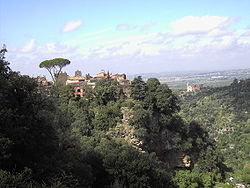This article has multiple issues. Please help improve it or discuss these issues on the talk page . (Learn how and when to remove these messages)
|

Villa Gregoriana is a park in Tivoli, Italy, located at the foot of the city's ancient acropolis. It consists mainly of thick woodland with paths that lead to the small circular Roman Temple of Vesta, the caves of Neptune and the Sirens, which form part of a series of gorges and cascades, and to the Great Waterfall.
Contents

The park was commissioned by Pope Gregory XVI in 1835 to rebuild the bed of the Aniene River, which had been damaged by the flood of 1826. The Aniene River Valley and Villa Gregoriana were submitted in 2006 for consideration as a UNESCO World Heritage Site. [1]